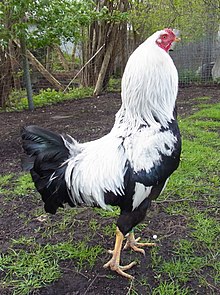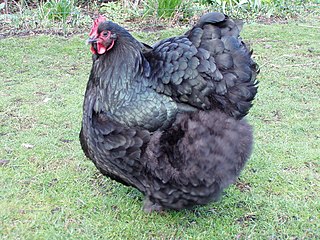
The Orpington is a British breed of chicken. It was bred in the late nineteenth century by William Cook of Orpington, Kent, in south-east England. It was intended to be a dual-purpose breed, to be reared both for eggs and for meat, but soon became exclusively a show bird.

The Barnevelder is a Dutch breed of domestic chicken. It resulted from cross-breeding between local Dutch chickens and various "Shanghai" birds imported from Asia to Europe in the later part of the nineteenth century; these may have been of Brahma, Cochin or Croad Langshan type. It is named for the town and gemeente (municipality) of Barneveld, in Gelderland in the central Netherlands. The hens are good layers of large brown eggs and, unlike some other breeds, continue to lay well during winter.

The Cochin is a breed of large domestic chicken. It derives from large feather-legged chickens brought from China to Europe and North America in the 1840s and 1850s. It is reared principally for exhibition. It was formerly known as Cochin-China.

The Scots Dumpy is a traditional Scottish breed of chicken. It is characterised by very short legs, so short that the body is a few centimetres from the ground; as in other breeds of creeper chicken, this chondrodystrophy is caused by a recessive lethal allele. The Dumpy has at times been known by other names, among them Bakie, Corlaigh, Crawler, Creeper and Stumpy. There are both standard-sized and bantam Scots Dumpies. It is one of two Scottish breeds of chicken, the other being the Scots Grey.

The Japanese Bantam or Chabo is a Japanese breed of ornamental chicken. It is a true bantam breed, meaning that it has no large fowl counterpart. It characterised by very short legs and a large upright tail that reaches much higher than the head of the bird.

The Dominique is an American breed of chicken, characterized by black-and-white barred plumage and a rose comb. It is considered to be the oldest American chicken breed, and is thought to derive from birds brought to America by colonists from southern England. It was well known by about 1750, and by the mid-nineteenth century was widely distributed in the eastern United States. It is a dual-purpose breed, but is kept principally for its brown eggs. It became an endangered breed in the twentieth century, but numbers have since recovered.
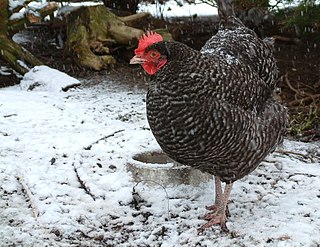
The Marans, French: Poule de Marans, is a French breed of dual-purpose chicken, reared both for meat and for its dark brown eggs. It originated in or near the port town of Marans, in the département of Charente-Maritime, in the Nouvelle-Aquitaine region of south-western France.

The New Hampshire Red or New Hampshire is an American breed of chicken. It was developed in the early twentieth century in the state of New Hampshire by selective breeding of Rhode Island Red stock; no other breed was involved. It is fast-growing, early-maturing, quick-feathering, and yields a meaty carcass. Mature birds are a light or medium red in color; they may fade in sunlight.
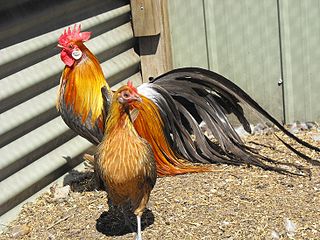
The Phoenix is a German breed of long-tailed chicken. It derives from cross-breeding of imported long-tailed Japanese birds similar to the Onagadori with other breeds.

The Magpie is a British breed of domestic duck. It has distinctive black and white markings reminiscent of the European magpie, and is a good layer of large eggs.

The Lakenvelder or Lakenfelder is a breed of domestic chicken from the Nordrhein-Westfalen area of Germany and neighbouring areas of the Netherlands. It was first recorded in 1727.

The Houdan or Poule de Houdan is an old French breed of domestic chicken. It is named for its area of origin, the commune of Houdan, in the département of Yvelines to the west of Paris. It belongs to the crested chicken group, is muffed and bearded, has an unusual leaf-shaped comb, and has five toes on each foot rather than the usual four.
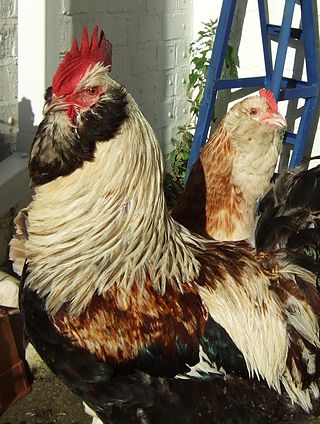
The Faverolles is a French breed of chicken. The breed was developed in the 1860s in north-central France, in the vicinity of the villages of Houdan and Faverolles. The breed was given the name of the latter village and the singular is thus also Faverolles, not Faverolle. The final "s" is silent in French.

The Dutch Bantam is a breed of bantam chicken originating in the Netherlands. It is a true bantam, a naturally small bird with no related large fowl from which it was miniaturized. It is kept mainly for exhibition, and has been bred in many color varieties; it is a good layer of small eggs.

The Booted Bantam or Dutch Booted Bantam is a European breed of true bantam chicken. It is characterised by abundant feathering on the feet and shanks, which gives it a "booted" appearance; and by vulture hocks, long stiff downward-pointing feathers on backs of the thighs, from which the Dutch name Sabelpoot ("sabre-legged") derives.

The Fayoumi or Egyptian Fayoumi is an Egyptian breed of chicken. It originates from – and is named for – the governorate of Fayoum, which lies south-west of Cairo and west of the Nile. It is believed to be an ancient breed.

The Barbu de Watermael, Dutch: Watermaalse Baardkriel, is a Belgian breed of bantam chicken. It originated in the Belgian town of Watermael-Boitsfort, from which it takes its name, which means "bearded [chicken] from Watermael". It is closely related to the Barbu d'Anvers, but is distinguished from it by its small, backswept crest of feathers. The Barbu de Boitsfort is a rumpless variation, the only difference being that it lacks the uropygium, the part of the anatomy that carries the tail.

The Brabanter is a Dutch breed of crested chicken originating in the historic region of Brabant which straddles Belgium and the Netherlands. It is an ancient breed and is shown in 17th-century paintings. A bantam Brabanter was created in around 1934.
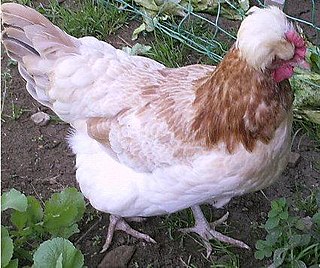
The Sulmtaler is an Austrian breed of domestic chicken. It originates in the Sulmtal, the valley of the Sulm river, in southern Styria, in the south-east of Austria, and takes its name from that valley.

The Friesian or Frisian, Dutch: Fries Hoen, is an ancient Dutch breed of chicken. It originates in Friesland, on the North Sea coast of the northern Netherlands.
